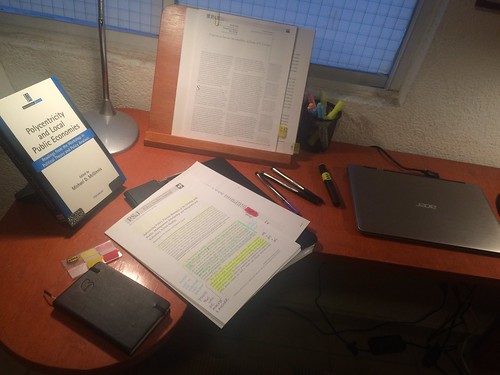While I took a course in speed reading when I was very, very young (probably 8 or 9 years old, at the most), and I can speed read, there are times when I, too, find myself overwhelmed by the sheer amount of reading I need to do. While I’ve written before on how you can be strategic about it and you don’t need to Read All The Things, even though I’ve written on 8 strategies to keep up with reading during teaching-heavy semesters, and how integrating your reading with your writing can help you out, I always find that there’s a lot I more need to read. There is always something else that needs to be read (and graduate students’ work actually takes a lot of time to read and provide feedback on!).
During a conversation with Dr. Pat Thomson (who also writes about, and studies academic writing) on Twitter, she mentioned that there is always a repertoire of strategies, that no writing or reading or planning or organizing strategy can be applied to all cases, and that students and early-career scholars must learn how to create a repertoire.
@raulpacheco I know you know this. apols for hectoring. Just know probs of people looking for recipes rather than repertoire of strategies.
— pat thomson (@ThomsonPat) July 1, 2016
I agree with Pat’s viewpoint, and in this set of blog posts I’m going to describe my own strategy to keep up with reading by using different reading strategies. I’ve written about how I always read the paper even if briefly (skimming) and THEN decide what to do with it. This is the Touch One Time rule that I describe in my Protocol “From PDF to Memorandum”.
The first strategy one needs to apply (and I’m definitely the first one to use it) is “skimming“. That is, you don’t need to read the full paper in detail, you can read *some* components of the paper in enough detail that you can either
- (a) write a rhetorical precis,
- (b) start drafting (and follow up, when you have more time) an in-depth memorandum, or
- (c) write notes to yourself cross-linking with research you’ve done or you’ve seen.
Many people do this three-stages process (skimming, note-taking and cross-linking) on the reference manager of their choice (I use Mendeley). I don’t usually do that, however. What I do is that I write notes to myself on an adhesive piece of paper (Post-It notes) that I then locate on the margins of the physical journal volume (I don’t like highlighting or scribbling on my physical versions of journals – I treat them like my books) and/or on the margins of the journal article or book chapter, if it is printed.
Rationale for removing street vendors mentioned by Roever & Skinner consistent w/ Mexican case pic.twitter.com/DEcxFBmKf1
— Dr Raul Pacheco-Vega (@raulpacheco) January 14, 2017
Once I finish skimming the article/book chapter/document, I copy my comments on to my Everything Notebook (or, if I plan to write a full memorandum, on to the draft of my memorandum).
This is how I "scribble notes to myself" in my memos: Linking two different articles through one idea. pic.twitter.com/1AuV33VX7F
— Dr Raul Pacheco-Vega (@raulpacheco) January 19, 2017
There is, I acknowledge, a solid advantage to doing the skimming, scribbling and cross-linking online (using a memorandum strategy): you already have the draft text that you could edit and then copy on to a manuscript’s literature review. But as I’ve written before often, I am very analog. I learn better when I write by hand. Plus, it’s easier and faster to do a mind-map when I need to link several different ideas.
I copy my scribbles on journal articles on to my Everything Notebook (and then memo/rhetorical précis) pic.twitter.com/Czf7tdJyz1
— Dr Raul Pacheco-Vega (@raulpacheco) January 17, 2017
Different authors will tell you how they skim (some people teach skimming and scanning simultaneously – where skimming is reading-superficially and scanning is reading-by-finding-a-key-element-throughout). Some of them will read only the abstract, others will read the abstract, the introduction and the conclusions. Others will do (as I recommend my own students) to read the first sentence of each paragraph of the article. Here’s a brief guide on how to skim and scan.
Regardless of the strategies you use to do fast reading (skimming or scanning), I always recommend that you always scan/skim, scribble and cross-link with the other stuff you are reading. That way, you can build a better conceptual map, more accurately, and you can also reach concept saturation in your literature review faster.


0 Responses
Stay in touch with the conversation, subscribe to the RSS feed for comments on this post.